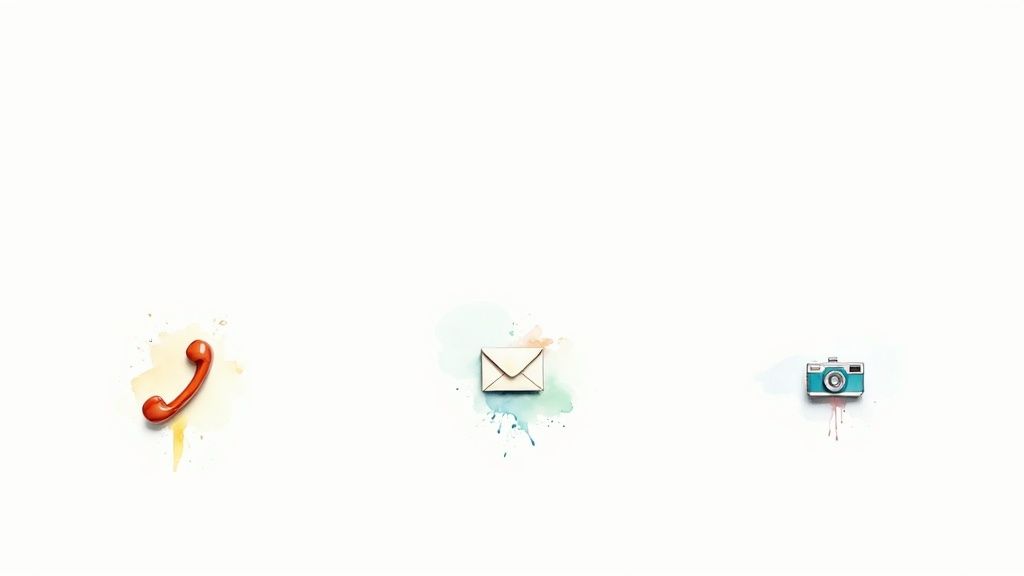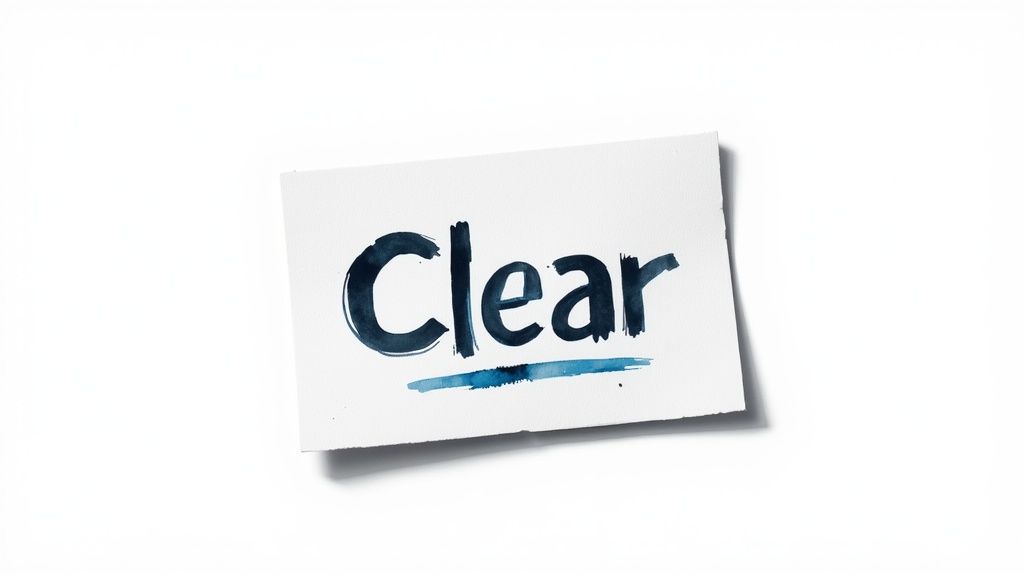Ignore Your Customers And Die Broke
Discover client communication best practices that top founders use to build trust, reduce churn, and scale faster without fluff.
Posted by
Related reading
Your Customer Service Isn't a Department, It's a Ticking Time Bomb
Tired of bad advice? Learn how to improve customer service by diagnosing real issues in your support tickets and delivering fixes that actually work.
Your Customer Feedback Loop Is a Joke. Fix It.
Stop guessing. Build a customer feedback loop that prints cash and stops churn. A no-BS guide for founders who'd rather build than theorize.
8 User Onboarding Best Practices I Wish I Knew Sooner
Stop bleeding users. Learn 8 battle-tested user onboarding best practices from a founder who’s been in the trenches. No fluff, just what works.
Let's cut the crap. You're busy. You hear "client communication" and your eyes glaze over, picturing another HR seminar with trust falls and beige PowerPoints. I get it. We've all been there, drowning in user comments, support tickets, and vague survey results, trying to find a signal in the noise. Most founders give up. They either delegate it to an intern who pulls out vanity metrics, or they 'listen' by only hearing what they want to hear.
And then they wonder why their churn rate looks like a ski slope and their product roadmap is a list of features nobody asked for. Here's the hard truth: ignoring your customers' unfiltered, messy, often brutal feedback isn't just lazy, it's a death sentence. The power of communication is evident when addressing negative feedback, as seen in strategies for improving guest reviews with better communication, and the same principles apply everywhere from SaaS to CPG. Your customers are screaming the answers to your biggest growth problems, but you're too busy "innovating" to listen.
You think you need more data. You need less bullshit. This article isn't a theoretical lecture; it's a field manual from the trenches. We're breaking down ten actionable client communication best practices you can implement today, whether you're a SaaS founder, a restaurant operator, or an event planner. Let's fix that.
1. Active Listening: Stop Waiting for Your Turn to Talk
Most founders don't listen; they reload. You’re on a client call, half-hearing them while formulating your genius response. Stop it. Active listening isn't some soft skill from a corporate retreat; it's a diagnostic tool. It's about shutting up long enough to understand what the client actually means, not just what they're saying. This is one of the most fundamental client communication best practices because it prevents you from building useless shit.

A user might say, "this feature is confusing," but what they often mean is, "I feel stupid using your product and I'm about to churn." If you just tweak a button, you’ve missed the real issue. Zappos built its empire on this, training reps to hear the frustration behind a return request. Ignore the underlying emotion, and you’ll be lucky to survive the quarter.
How to Actually Do It
- Reflect, Don't React: Use phrases like, "So what I'm hearing is..." It forces you to process their words instead of just defending your ego.
- Embrace the Awkward Silence: Ask a question, then shut up. Let them fill the space. The gold is always in the follow-up thought they have when you don't interrupt.
- Summarize the Mission: End critical conversations with a follow-up email outlining what you heard. It proves you were listening and creates accountability.
Takeaway: Hear what they mean, not just what they say, or you'll solve the wrong damn problem.
2. Multi-Channel Communication: Stop Forcing Clients Into Your Favorite Inbox
Your clients don't live on a single channel, so why is your communication strategy stuck in 2005? Forcing everyone to use email when they live on Slack is lazy and arrogant. Multi-channel communication isn't about being everywhere; it's about being where your clients are, and it's one of the most critical client communication best practices for reducing friction. You’re making them do the work.

Amazon lets you track a package, start a return, and talk to support via their app, site, and email without missing a beat. They don't care which door you use. To effectively reach your clients, understand the principles of multichannel marketing. Ignore this, and you’re just telling high-value clients that their convenience doesn't matter.
How to Actually Do It
- Centralize Your Intel: Use a unified inbox tool. Pull all conversations from email, chat, and social media into one place. This stops your team from looking like they have amnesia.
- Set Channel-Specific SLAs: A 24-hour email response is fine; a 24-hour live chat response is a joke. Define and publish clear response times.
- Analyze and Prioritize: Don't just guess. Use analytics to see where your clients live. If 80% of inquiries come through web chat, triple down on that. Get more details on the ways to collect customer feedback on our blog.
Takeaway: Meet your clients where they are, not where you want them to be, or they’ll find someone who will.
3. Personalization: Stop Treating Your Clients Like Line Items
Using a client's first name in an email template isn't personalization; it's a party trick from 2010. Real personalization is demonstrating you actually know who they are. This is one of the most critical client communication best practices because it separates you from the robotic, one-size-fits-all competitors who see customers as database entries.
When Spotify creates a "Discover Weekly" playlist, it's whispering, "I've been paying attention." A hotel manager who remembers a guest prefers a corner room isn't just being nice; they are building an economic moat around that relationship. Ignore this, and you're just another commodity, waiting to be replaced by a cheaper option.
How to Actually Do It
- Weaponize Your Onboarding: Use the first conversation to ask about goals and deal-breakers. Don't just collect billing info; collect context.
- Reference Their History: Start conversations with, "Last time we talked about X..." It shows you remember them beyond the current ticket number.
- Let Them Steer: Give clients control over communication preferences. Forcing everyone into the same experience is lazy and disrespectful.
Takeaway: Generic service gets you generic results—specifically, churn and apathy.
4. Transparency: Stop Hiding the Ugly Truth
Selling your client a perfect version of your service is a rookie mistake. You hide the messy parts, hoping they won't notice. This isn't just dishonest; it's a ticking time bomb. Transparency isn't over-sharing; it's about setting brutally honest expectations. This is a non-negotiable client communication best practice because it turns potential disasters into manageable problems.
When Buffer had a massive data breach, they didn't wait for the story to leak. They got ahead of it, immediately disclosing what happened. They treated their users like adults, not idiots. The result? They strengthened their brand reputation instead of destroying it. Treat your clients like partners in navigating reality.
How to Actually Do It
- Disclose Problems Proactively: If a project is at risk, you tell them first. Don't let them discover it. Share the bad news fast, along with your plan to fix it.
- Explain the 'Why' Behind the 'No': Instead of a flat "no," explain the technical limitations or strategic reasons. It shows respect.
- Document Everything: Put agreements in writing. A clear contract prevents "he said, she said" arguments.
Takeaway: A client who knows the whole truth will trust you far more than one you’ve sold a fantasy to.
5. Proactive Communication: Stop Fighting Fires, Start Building Fences
Reactive support is a slow-motion company death. You wait for the client to scream, then you scramble. Proactive communication is seeing the smoke and handling it before your client even smells it. This isn't a "nice to have," it's one of the most crucial client communication best practices for preventing churn before it craters your P&L.
This is the entire playbook for customer success. SaaS companies flag accounts with dropping usage rates and reach out before they cancel. A good IT provider doesn't wait for a system to crash; they alert clients to a new security threat and patch it first. Letting your client discover a problem is a declaration of incompetence.
How to Actually Do It
- Schedule Your Intel: Establish a regular schedule for updates, even if there’s no "news." A simple monthly check-in prevents clients from feeling ignored.
- Anticipate the Obvious: Document every question you get more than twice. Turn the answers into a guide or a proactive email you send to all new clients.
- Weaponize Your Data: Use analytics to spot patterns that predict trouble. If clients who skip onboarding are 50% more likely to churn, build an automated alert to nudge them.
Takeaway: Solve problems before your clients know they have them, or they'll find someone who will.
6. Empathy: Stop Treating People Like Help Tickets
Logic solves technical problems, but empathy solves human problems. Your business is a mix of both. Emotional intelligence isn't about being nice; it's a strategic advantage. Your clients aren't just buying software; they're trying to get a promotion, avoid looking stupid in front of their boss, or save their own struggling business. This is one of the most critical client communication best practices because it addresses the human driver behind the transaction.

A client complaining about a small bug might actually be panicking about a looming deadline. When you ignore the emotion, you’re just a commodity, easily replaced by a cheaper competitor who also doesn't care.
How to Actually Do It
- Use Validating Language: Start with "I can see why that would be frustrating" instead of jumping to a solution. Acknowledging their emotion disarms them.
- Practice Perspective-Taking: Before a call, spend 30 seconds thinking: "What pressure is this person under? What does a 'win' look like for them personally?"
- Ban Defensive Language: When a client is upset, train your team to absorb the feedback first. Replace "Our system wasn't designed for that" with "Let's figure out how we can make this work for you."
Takeaway: Your client is a human, not a help ticket; treat them like one or they’ll find someone who will.
7. Clear Communication: Ditch the Corporate Jargon
Your clients are busy. They don't have time to decode your MBA-speak. Clear communication isn't about dumbing things down; it's about respecting their time. It’s a core tenet of client communication best practices because confusion creates friction, and friction kills deals. You sound smart by being understood, not by using big words.

If you send a client a proposal full of industry jargon, you've already lost them. Apple doesn't sell a "polycarbonate unibody enclosure"; it sells a durable, beautiful laptop. Adopt that mindset. Your internal slang is for your team, not the people paying your invoices.
How to Actually Do It
- Write Like You Talk: Read your emails out loud. If it sounds like a robot wrote it, rewrite it.
- Front-load the Mission: Put the most critical information first. A client shouldn't have to read five paragraphs to find the one action item.
- The "Explain to a 5th Grader" Test: If a smart but uninformed person wouldn't understand it, you’ve overcomplicated it. Use bullet points and short sentences.
Takeaway: If your client needs a translator to understand you, you’ve already failed.
8. Responsiveness: Speed Is a Feature
Slow responses kill deals. Your client sent a question four days ago, and your team is still "looking into it." In that time, they’ve mentally fired you and started Googling your competitors. Responsiveness isn't just polite; it's a core feature of your service. It screams, "we respect your time." This is one of the most critical client communication best practices because it builds trust faster than any sales pitch.
Amazon weaponized speed. Same-day delivery set a new standard that made everyone else look lazy. If you treat client messages like a low-priority chore, expect to be treated like a disposable vendor. Inaction is a decision that will bleed you dry.
How to Actually Do It
- Set Public Expectations: Publish your response times. A simple "we reply within 4 business hours" on your contact page prevents anxiety.
- Automate Acknowledgment: Implement an auto-reply that confirms you received the message. It’s a low-effort way to show you’re on the case.
- Use Templates for Speed: Create smart, non-robotic templates that let you respond in seconds, not hours. This shows efficiency. The goal is to increase customer engagement by resolving issues faster.
Takeaway: Respond with urgency or watch your clients walk away with urgency.
9. Storytelling: Stop Spewing Features
Facts tell, stories sell. If you’re just spewing data at clients, you’re making them do the hard work. Storytelling isn't for campfires; it's for closing deals. It wraps your value proposition in a narrative that engages the emotional, decision-making part of the brain. This is a core element of effective client communication best practices because it turns a transaction into a memorable experience.
Your SaaS product isn't "a cloud-based workflow automation tool." It's the reason a stressed-out marketing manager got to see her kid's soccer game instead of working late. Donald Miller’s StoryBrand framework is built on this: position the client as the hero and your business as their guide. If you can’t tell a compelling story about how you solve a problem, you don’t have a business, you have a science project.
How to Actually Do It
- Follow the Arc: Character has a problem, meets a guide, gets a plan, and avoids failure. Frame your solution within this arc.
- Make the Client the Hero: You are not Luke Skywalker; you are Yoda. Your product is the lightsaber that helps them defeat their "Empire."
- Use Specific Details: Don't say you "improved ROI." Say, "we helped a local restaurant save $15,000 in wasted inventory, which they used to open a second location." Details are believable.
Takeaway: Stop listing features and start telling the story of the success your client will have with you.
10. Feedback: Ask for It, Then Actually Use It
Thinking you know what your clients want is founder malpractice. You don't. Actively soliciting feedback isn't about being nice; it's a brutal, necessary loop of survival. This is a core tenet of client communication best practices because it forces you to confront reality instead of your own biased roadmap.
This isn’t just sending a flimsy NPS survey. Amazon weaponized customer reviews to build an empire. A software company that ignores user feedback in favor of its "vision" is already dead. Ask for feedback, listen, and then prove you weren't just asking to check a box by actually doing something about it. Anything less is just business theater.
How to Actually Do It
- Make It Effortless: Your feedback request should take less than 60 seconds. A single-question survey is better than a 20-question monster nobody finishes.
- Close the Loop, Publicly: When you make a change based on feedback, announce it. "You asked, we listened. The new XYZ feature is live." This shows their voice has impact.
- Combine Scores with Stories: An NPS score tells you what is happening. The optional comment box tells you why. The qualitative data is where the gold is.
Takeaway: Ask your clients what they hate, then fix it. Repeat until you’re unbeatable.
Top 10 Client Communication Best Practices Comparison
| Practice | Implementation Complexity 🔄 | Resource Requirements ⚡ | Expected Outcomes 📊 | Ideal Use Cases 💡 | Key Advantages ⭐ |
|---|---|---|---|---|---|
| Active Listening | Medium — requires training and time | Low–Medium — staff time, training | Stronger trust; fewer misunderstandings | High-touch service, counseling, advisory | Builds rapport; uncovers true needs |
| Multi-Channel Communication | High — integration and coordination | High — platforms, CRM, staffing | Greater accessibility and faster responses | Retail, banking, large customer bases | Broad reach; meets customer preferences |
| Personalization & Customization | High — data, analytics, governance | High — data infrastructure, compliance | Higher conversions; increased loyalty | E‑commerce, SaaS, finance, marketing | More relevant experiences; higher CLV |
| Transparency & Honesty | Low–Medium — policy + cultural change | Low — documentation, staff training | Strong trust; fewer disputes and legal risk | Professional services, product disclosures | Builds credibility; reduces surprises |
| Proactive Communication | Medium — forecasting and scheduling | Medium — analytics, automation | Prevents issues; boosts confidence | Customer success, IT, insurance | Prevents escalation; shows expertise |
| Empathy & Emotional Intelligence | Medium — training and culture shift | Medium — training, coaching, hiring | Improved satisfaction; better conflict resolution | Hospitality, service recovery, counseling | De‑escalates issues; strengthens loyalty |
| Clear & Concise Communication | Low — editing and style enforcement | Low — time for crafting and review | Fewer errors; faster decisions | Technical docs, user instructions, UX | Improves understanding; speeds action |
| Responsiveness & Timely Follow‑Up | Medium — SLAs and tracking processes | Medium — staffing, CRM, automation | Higher reliability perception; fewer missed items | Support desks, sales, professional services | Demonstrates reliability; increases retention |
| Storytelling & Narrative Communication | Medium — content development skills | Low–Medium — creative time, examples | Stronger engagement and message retention | Marketing, sales pitches, fundraising | Emotional connection; memorable messaging |
| Feedback Solicitation & Continuous Improvement | Medium — collection + analysis workflows | Medium — survey tools, analysis, action resources | Actionable insights; product/service improvements | Product teams, CX programs, service design | Direct client insight; continuous adaptation |
Stop Admiring the Problem
You just scrolled through a dozen best practices. Let’s be blunt: you didn't learn anything new. Active listening, transparency, being proactive—it’s not rocket science. The problem isn't a knowledge gap; it's an execution gap. It’s the chasm between knowing you should be responsive and actually having a system that ensures you are, even when your hair is on fire.
Most of your competitors read the same blogs. They nod along. But they treat communication as a soft skill that depends on individual heroics. They hope their team members are having a good day. Hope is not a strategy. Winning founders don't hope; they build systems.
Your client communication is not an art form. It's your company's core operating system. When it's buggy, you get churn and bad reviews. When it's optimized, you get loyalty and referrals. The difference between the business that thrives and the one that struggles is who stops admiring the problem and starts building the machine.
Your Actionable Blueprint
Don't just close this tab. Pick one of these ideas and build a process this week.
- Systematize Proactive Updates: Create a mandatory "Proactive Client Update" milestone in your CRM. For an event planner, this could be a weekly "Vendor Status Confirmed" email. For a SaaS founder, a bi-weekly "Product Roadmap Sneak Peek" for key accounts.
- Build a Feedback Engine: Automate a simple, three-question survey that goes out 30 days after onboarding or one week after a hotel stay. Consistency beats sophistication.
- Script Your Transparency: Pre-script your "bad news" templates now. What is your exact process when a feature launch is delayed? Having a pre-approved template removes the emotional hesitation and ensures your response is swift and professional, not panicked.
These aren’t just tips; they are the building blocks of a resilient operation. Mastering these client communication best practices isn't about being nicer; it’s about being smarter. Your competitors are still just talking about it. Go build it.
Stop guessing what your clients want and let Backsy show you the raw, undeniable truth buried in your customer feedback.